Raymarine LightHouse 14 sailing features, as good as they look?
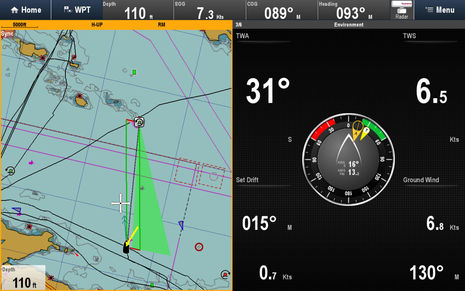 When pretending to sail, I go for high performance. That’s why the screen above seems to show Gizmo exceeding true wind speed while extremely close hauled. But pretending is also why I can’t truly review the new sailing features that came to all current Raymarine multifunction displays last May, thanks to a free LightHouse 14 operating system update. Additionally, most of the features described in the press release are about racing, which I did little of even when I was sailing a lot. But let’s walk through the new Raymarine MFD capabilities anyway, and hopefully we’ll hear from sailors who’ve actually used these tools or the similar ones offered by B&G and Garmin…
When pretending to sail, I go for high performance. That’s why the screen above seems to show Gizmo exceeding true wind speed while extremely close hauled. But pretending is also why I can’t truly review the new sailing features that came to all current Raymarine multifunction displays last May, thanks to a free LightHouse 14 operating system update. Additionally, most of the features described in the press release are about racing, which I did little of even when I was sailing a lot. But let’s walk through the new Raymarine MFD capabilities anyway, and hopefully we’ll hear from sailors who’ve actually used these tools or the similar ones offered by B&G and Garmin…
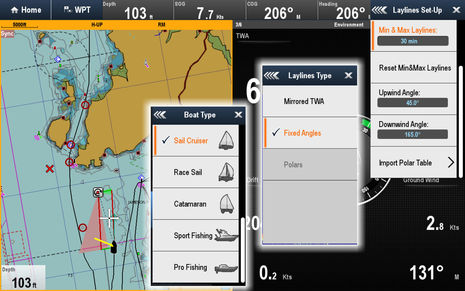 In fact, current Raymarine, Garmin and B&G MFDs can now all calculate laylines. To see the Ray version above — or any of the sailing features in LightHouse 14 — you first need to choose one of the three boat types that might typically tack to a mark. Then you need to activate a waypoint or route and decide which of the three layline types you want to use. Mirrored TWA (True Wind Angle) is the easiest, with the next tack simply calculated as the opposite of whatever angle you’re currently happy with. Or you can establish target upwind and downwind angles, and then be reminded about what you think your boat can do. Note that if you enable a Min & Max Laylines time period, the shaded triangles will show the shift history — 30 minutes was too long — and that if your laylines separate by more than 170 degrees, they disappear (because you’re reaching).
In fact, current Raymarine, Garmin and B&G MFDs can now all calculate laylines. To see the Ray version above — or any of the sailing features in LightHouse 14 — you first need to choose one of the three boat types that might typically tack to a mark. Then you need to activate a waypoint or route and decide which of the three layline types you want to use. Mirrored TWA (True Wind Angle) is the easiest, with the next tack simply calculated as the opposite of whatever angle you’re currently happy with. Or you can establish target upwind and downwind angles, and then be reminded about what you think your boat can do. Note that if you enable a Min & Max Laylines time period, the shaded triangles will show the shift history — 30 minutes was too long — and that if your laylines separate by more than 170 degrees, they disappear (because you’re reaching).
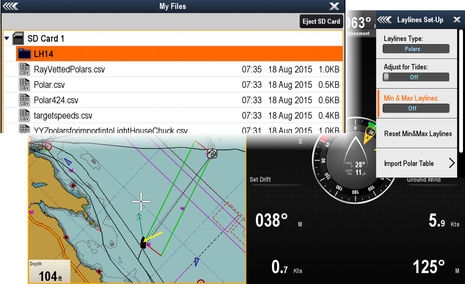 I believe that Garmin and B&G each have somewhat different ways of controlling and displaying laylines, but that Raymarine is the first to enable polars right in the MFD. That means the display can calculate laylines based on a table describing your boat’s speed at various wind angles and points of sail. I found the upload process to be easy, though I noticed on the Raymarine Tech forum that there has been some difficulty with .csv files created on Mac computers. The forum is also a good place to snatch polar tables that will definitely work (like I did) and which you can modify for your boat, or you may find appropriate ones via Google (like these). Note that you may want more than one polar table for different sea conditions, desired comfort levels, or even motor sailing, and switching them on a Ray MFD is dead simple.
I believe that Garmin and B&G each have somewhat different ways of controlling and displaying laylines, but that Raymarine is the first to enable polars right in the MFD. That means the display can calculate laylines based on a table describing your boat’s speed at various wind angles and points of sail. I found the upload process to be easy, though I noticed on the Raymarine Tech forum that there has been some difficulty with .csv files created on Mac computers. The forum is also a good place to snatch polar tables that will definitely work (like I did) and which you can modify for your boat, or you may find appropriate ones via Google (like these). Note that you may want more than one polar table for different sea conditions, desired comfort levels, or even motor sailing, and switching them on a Ray MFD is dead simple.
 The Ray crew also created a nice LightHouse 14 New Features manual which can still be downloaded here, but may get folded into the regular user manual when LightHouse 15 actually becomes available. And yes, as this manual page suggests, LH 14 includes a racing timer and start line builder. But first let’s look at a course route builder feature that is also unique to Raymarine at this point (I’m pretty sure).
The Ray crew also created a nice LightHouse 14 New Features manual which can still be downloaded here, but may get folded into the regular user manual when LightHouse 15 actually becomes available. And yes, as this manual page suggests, LH 14 includes a racing timer and start line builder. But first let’s look at a course route builder feature that is also unique to Raymarine at this point (I’m pretty sure).
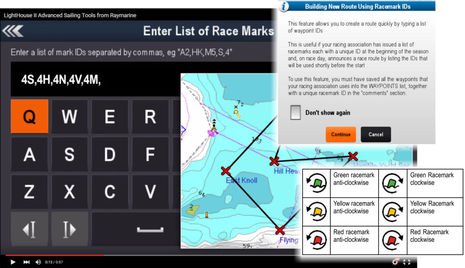 So there’s a new choice in the My Data/Routes menu called Build Using Racemark IDs, which are just abbreviations you’ve added to the comments section of desired waypoints. You simply list them as shown in the Advanced Sailing Tools video screen captured above and, bada boom, the race route is done. There’s even a helpful pop-up (upper right) when you actually try it. And perhaps the icing on the cake are the nifty racemark icons that Ray added to their waypoint library (which is such a useful but simple idea that I can almost hear the face slaps emanating from competitor shops). Of course, all this is particularly helpful when you race regularly in the same area with standard marks, but couldn’t the quick route building also be useful to anyone who just cruises the same area in many different ways?
So there’s a new choice in the My Data/Routes menu called Build Using Racemark IDs, which are just abbreviations you’ve added to the comments section of desired waypoints. You simply list them as shown in the Advanced Sailing Tools video screen captured above and, bada boom, the race route is done. There’s even a helpful pop-up (upper right) when you actually try it. And perhaps the icing on the cake are the nifty racemark icons that Ray added to their waypoint library (which is such a useful but simple idea that I can almost hear the face slaps emanating from competitor shops). Of course, all this is particularly helpful when you race regularly in the same area with standard marks, but couldn’t the quick route building also be useful to anyone who just cruises the same area in many different ways?
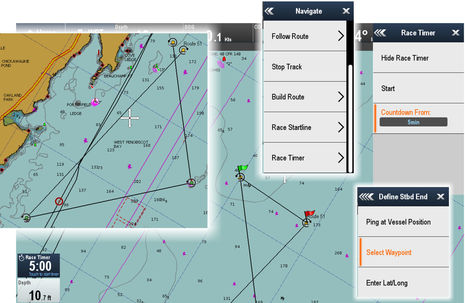 At any rate, the race course route building worked fine for me, as did the flexible race timer and the startline builder. But what’s missing? Well, Garmin’s Start Guidance diagrammatic window with values like Distance to Line and Time to Burn seems quite useful (and similar is available on B&G when H5000 gear is in the mix, ditto for polars). Perhaps what is more important, especially for cruisers, is that Raymarine does not yet seem able to total up the predicted laylines to get the useful info B&G calls SailTime, seen below as TTW-S (Sailing Time to Waypoint) and DTW-S (Sailing Distance, and there’s also ETA-S available). I don’t think a Garmin MFD can do this math either, though it may well be possible with some of the Nexus add-ons.
At any rate, the race course route building worked fine for me, as did the flexible race timer and the startline builder. But what’s missing? Well, Garmin’s Start Guidance diagrammatic window with values like Distance to Line and Time to Burn seems quite useful (and similar is available on B&G when H5000 gear is in the mix, ditto for polars). Perhaps what is more important, especially for cruisers, is that Raymarine does not yet seem able to total up the predicted laylines to get the useful info B&G calls SailTime, seen below as TTW-S (Sailing Time to Waypoint) and DTW-S (Sailing Distance, and there’s also ETA-S available). I don’t think a Garmin MFD can do this math either, though it may well be possible with some of the Nexus add-ons.
But of course all this is subject to change (if I did get it right), and that’s the bigger picture here. Raymarine LightHouse software went for years without doing much specifically for the many sailors who use Ray gear and then, pow, this whole feature bundle arrives for free and works on every MFD they’ve made for a while. And every MFD developer is capable of such nice surprises these days, and of course all are regularly improving the features they already offer. Rejoice, at least until that dreaded day when your main system manufacturer feels the need to upgrade its hardware so it can do things yours never will.
Now who out there has sailed or raced with Raymarine’s new features or similar? What worked for you, what didn’t, and what else do you want?


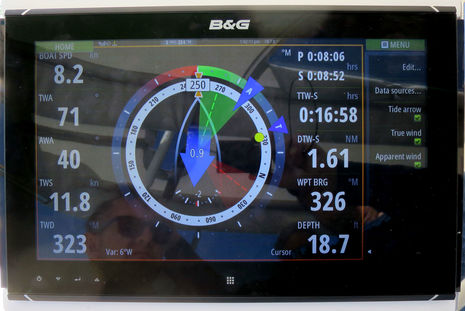
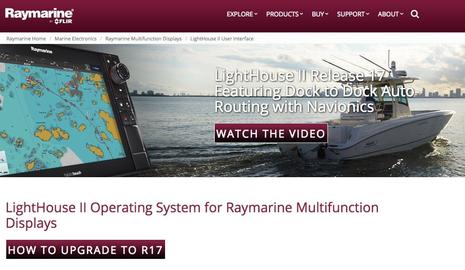
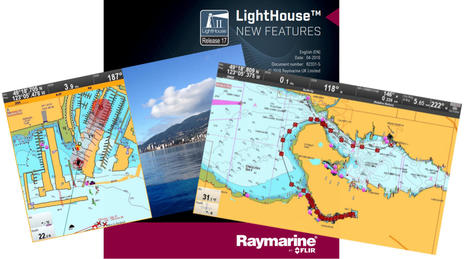









I have my fingers crossed for a new release of sailing tools in a future release, as i otherwise love my new raymarine mfd.
Until then, the race tools go unused except for the race time. I like the race timer vs. my kitchen timer, because with Raymarine if your off by quite a bit at the 5 min start, hit it again at 4 or 1 minute, and it gets right back in sync.
The big disappointment is the lack of time to burn coming into the start line, without those features I don’t find much value in performing the numerous steps to setup start line. When it does come (hopefully it is added) I hope they add a capability to define where your GPS is relative to the bow of the boat, as my gps is on the stern of my 39 foot boat. Depending on wind conditions, they can make a difference of 4 to 12 seconds (2 knot vmg to windward = 12 seconds).
It would also be ideal if there were many less steps to jump through sub menus to setup the two ends of the race line. I would appreciate if the number of screen presses were cut in half! For example if I could just choose the two ends of the line, without choosing starboard and port first in a sub menu, Raymarine could cut out a bunch of presses, then guess what side of the line I am on (almost always the start side) and let me click once to swap port/stbd pin if I was on the other side.
A crushing disappointment is the layline feature being erratic, this could have been so useful to cruisers, especially considering Ray included set & drift in their math for laylines (go ray!). The layline feature is entirely useless right now as the laylines are very jumpy, they are moving around wildly, by 30 degrees or more every few seconds, which is a big surprise having really stable wind, heading, and boat speed at the time using some great sensors on my boat (airmar weather station, raymarine’s EV1). This needs to be fixed
Some other features that would be nice to have after time to burn is added, and laylines are fixed (both racing and cruisers)
#1 That the ST70 wind displays and MFD would have an option for displaying target stw based on current wind angle and speed, so my crew and I can see how close we are to target speed by choosing STW in a nearby window.
#2 Expand the existing polar feature, to include different sets of headsails. Then while racing, have a button somewhere to indicate which headsail set we are using (.e.g J&M140, J&M155, SPIN140, SPIN155, SPIN165)
#3 Just like being able to add an adjustment for leeway, add some fine tuning for wind offset. For example let us have a table where we can enter wind corrections (30 AWA port +3.5, 40 AWA port +2, 50 AWA port +0.5) These offsets are intended to compensate for how the wind instrument is effected by air currents coming off our headsails and hitting the wind sensor.
#4 Same adjustment for our speed through water sensor, but sensitive to us being on a port or starboard tilt and how much. Most of our boats misreport the stw based on heal, and if we are tilted port rather than starboard as our stw sensors are not on the centerline.
Thanks, Dan! I’ve been seeing fairly steady laylines but my testing has been limited. I’ll make sure to test them again if and when Gizmo goes to weather again.
Wouldn’t you value Tacking Time to Waypoint and similar calculations, at least when cruising?
Laylines seem more stable when conditions are not chaotic. Steady wind, smoother water. A lumpy sea and light wind drove them nuts. Obviously lots of masthead movement doesn’t help. I replaced my short arm wind transducer with a long arm and that’s helped get it into clean air, especially down wind.
Ben : Oh yes, tacking time to waypoint would be valued.
Another miss on the sailing features, just a small miss, – are the race mark icons showing clockwise or counter clockwise. That’s not workable. The direction around the mark is dependent on the specific race. Choosing the icon in advance, one way or the other is unhelpful.
Only when the course is posted do we know if a waypoint is a starboard or port rounding (letter is posted green or red on board). Also, like the course last Saturday the mark will show up twice or more in the same course with different roundings e.g. DBDAD, where the first D is green and the next two D’s are red.
Not to take away from the innovation of quickly entering a course, but the icon rounding aspect is unhelpful unless when entering the course, we could choose red or green in front of each mark and Raymarine would swap the icon displayed for rounding direction based on where we are in the course for the mark ahead based on that choice.
To add to the above, sailing distance would be valued too.
It would be impressive if set & drift, either at the current point in time or the prediction from the purchased maps, were taken into consideration for sailing distance and tacking time to waypoint.
Hi Dan,
The Raymarine software actually allows for this. For waypoints that don’t have inherent rounding properties in the symbol, you can apply rounding instructions from within the route plan. This allows a waypoint to be used multiple times within a race, and have different rounding instructions as you have described.
Nice! I captured a short smartphone video of the rapidly moving laylines, next to a data screen of wind and boat information. Should I send to tech support website or somewhere else? Jim McGowan and Ben have my contact info.
..And then, they release version 15 (day before yesterday)! No apparent changes to the sail-racing stuff, but a number of other possible good things, including the apparent ability of the wifi to integrate with outside bridges/routers. I installed it, but it will be several days (or more) before I can see what really happened.
Got out for a very nice daysail in San Diego today – not much time to exercise the chartplotter (too busy watching the two small girls cavorting onboard and the other boats who were out in multitudes) but I did notice one big change – AIS targets now come in at least three flavors: small, medium and large. Small looks like AIS targets always have (triangle); medium looks the same but bigger, large is a rectangle with a point at one end. So now you can tell the relative size of the AIS targets without having to drill down to the target data – I like it!
Right, and there are more new AIS icons than that, plus a whole new collision avoidance feature that can overlay red “target interception zones” on your chart if you like. Looks very interesting and I gather they plan more AIS improvements for Lighthouse 16.
But I think that the really big news is how LH 15 permits all current Raymarine WiFi MFDs to log onto marina and cell phone hot spots as well as boat routers. This unlocks all sorts of possibilities. And Raymarine remote control and viewing apps apparently still run fine in this mode (unlike the Navico WiFi-1 implementation, which is either/or).
A detailed PDF about the new LH 15 features can be downloaded here:
https://raymarine.app.box.com/s/8o1sxspkhvf8ev7smk40/1/1327412824
Prospective customers interested in using polars would be well advised to realize that on B&G it does not matter if you bought the latest B&G Zeus2 chart plotter, perhaps even a pair of them, all B&G Triton instruments, all B&G N2K sensors, perhaps even an autopilot, etc… the polars function will simply not be available on your system. Period.
If you want polars, you need to additionally buy an H5000 processor. Oh, this is clearly spelled out somewhere in the brochures, so it’s not like you don’t get advance warning. $1,499 + tax.
I was quite pleased (excited even! :-)) when I learned of new sailing/racing features in R14 but, to be quite honest, a couple of months into installing R14 on my boat, the new sailing features have remained completely unused – for either our weekly round-the-cans racing or for the weekend distance (short-handed) racing.
Bottom line is that, in the little time you have between when the RC sets the line until they sound the warning signal for the first start (when even if you’re in subsequent starts, you can no longer approach the line until your own warning signal) – there’s just too much going on that requires one’s attention to dig through the MENUS in order to find and configure the parameters.
Instead, I have (and continue to use) a Garmin quatix watch with a GNT-10 spliced into my Seatalk NG network – and that works quite well. I thought, when I read the announcements of sailing features in R14, that it will supersede that setup – but it’s not quite there yet.
If Raymarine was serious about providing features for racing sailors – my recommendation would be to create a new and separate mainscreen “app” called “Racing” which would be similar to the existing “Chart” app but with 2 columns of data boxes (one on each side) larger than the ones in the regular Chart app display and with access to racing timer and start line config as on-screen buttons (just push a “boat” button when you’re at the boat and “pin” button when you’re at the pin!) – no digging through menus!
Also, once a start line is configured – a quick way of setting up position of the weather mark would be great! Most round-the-cans racing does not use fixed marks so the mark mnemonics are fairly useless.. A “weather mark” on-screen button that brings up a “heading and distance” entry box would be great (most race committees post heading and distance to the w-mark on the committee boat).
Distance-to-line and time-to-burn would also be essential for start (otherwise, there’s little point to going through the trouble of marking the line – time better spend getting your port and starboard numbers)…
Once the weather mark is entered – distance and time to the layline (port or starboard – depending which way you’re going, of course) would also be very useful!
A wind-shift indicator (left-of-mean/right-of-mean) across the top of the screen would be a cherry on the cake!
But much (all) of that would be entirely useless in the chart display (and taking up valuable real estate space) if you’re in the cruising mode – which is why I suggested that this should be a separate “app” accessible from main screen…
But, hey, I am happy that Ray is at least looking into some of the sailing-specific features – so the above was not meant as a criticism of what they’ve done but, rather, suggestions of where IMHO it should go…
Marko
Great contribution to sailing feature improvement Marko! Right on the mark!
I agree with everything. great ideas. incidentally, I’ve been asking Raymarine for a year to allow setting up a waypoint by entering a bearing and distance from an existing waypoint. necessary for windward/leeward race courses. they said in 10 years I’m the only person that has ever asked for this!
hope we can get raymarine to focus on racing features.
John Doub
This is an old thread, but I wanted to add some further thoughts. Two years on, Raymarine has still not added any time/distance to starting line. This makes the start line feature virtually useless. Also, lay lines might be nice, but they only work if you also have speed through the water data available on the network. B&G calculates lay lines with GPS speed, but not Raymarine. So if they are thinking about racing sailors, they are not thinking very hard. It is unfortunate as this is not complicated stuff to implement given the data and processing power they have in these units.
I’m not as concerned with the “racing” features, but our Raymarine e95 treats the displayed “true wind arrow” and “true wind directions/velocity” readouts the same way – so they are useless if your “speed thru the water” sender is fouled 🙁